In all the time we’ve been here, I’ve only ever seen one frog. Just one. We hear them frequently, sometimes down by the creeks, other times up on the slopes above us, but they’re rather shy, and we have some very dense woodland here, so being able to find our elusive resident frogs hasn’t been easy.
This last weekend Mr. Curbstone went to retrieve the step ladder from behind the workshop, and as he carried the ladder down the hill toward the goat barn, suddenly…”plop”. He noticed that something fell out of the ladder, and landed on the driveway. A frog!
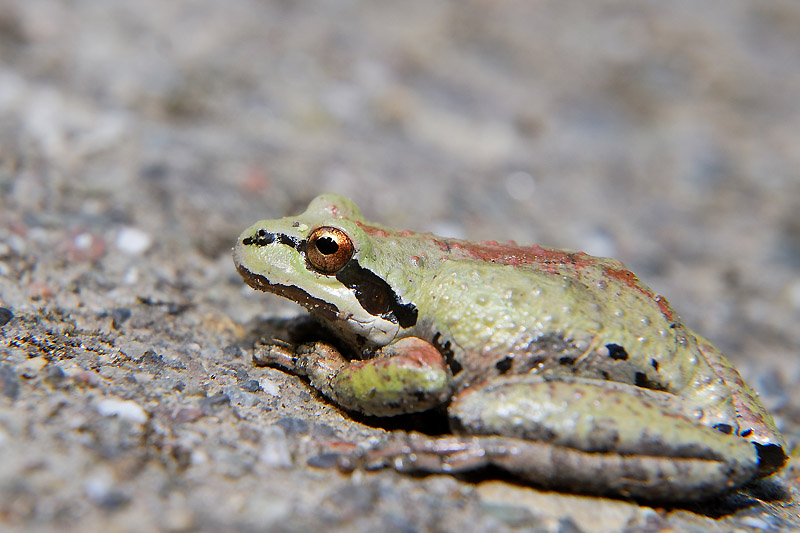

There it was, just sitting there, looking rather nonchalant. The frog seemed to have survived its aerial descent unscathed. I debated whether or not to try going in the house for my camera. From where the frog was sitting, it was an uphill dash, and usually in these situations, by the time I return, my subjects have either scurried, slithered, or hopped away!
Not this time though. Not only did this frog pose for a few preliminary shots, but it also stayed put while I ran back into the house a second time for my macro filter!
I had no idea who I was looking at, and I’m sure the feeling was mutual. However, scanning through the California Herps website, it didn’t take long to figure out who she was, although this species has had a slight identity crisis in recent years.
This species was once called the Pacific Chorus, or Pacific Treefrog (Pseudacris regilla), but in recent years taxonomists reclassified individuals in that group into three separate species. Pseudacris regilla is now known as the Northern Pacific Treefrog, and reserved for those individuals living along the far northern coast around Humboldt county, up through Washington state. Here in Central California, our local species is the Sierran Treefrog (Pseudacris sierra). The third species resides in southern California, called the The Baja California Treefrog (Pseudacris hypochondriaca).
As if that’s not confusing enough, depending on who you talk to, the common name for our Central California species is either the Sierran Treefrog, the Sierra Chorus Frog, or the Pacific Chorus Frog.



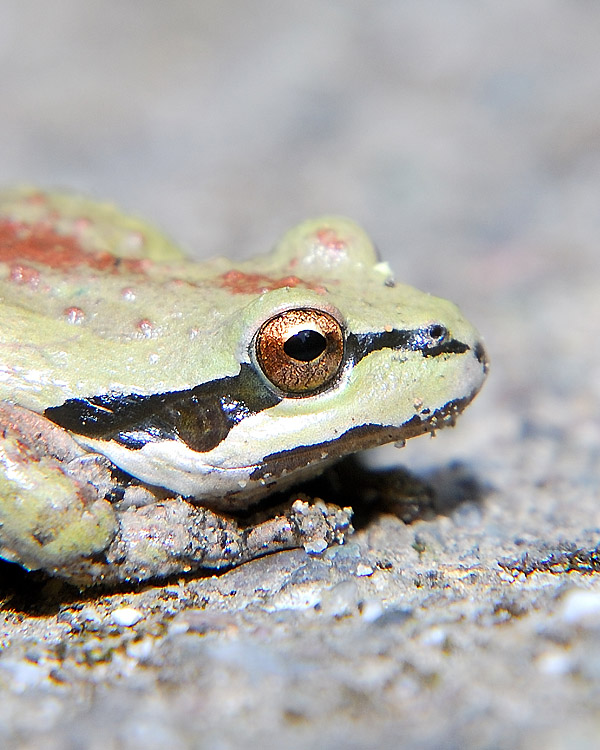
Personally, I prefer the Pacific Chorus Frog designation, as I can’t even see the Sierras from here, and I think Treefrog is somewhat misleading too, as these frogs reportedly spend most of their time on the ground.
All three of these Pseudocris species in California are extremely variable in color, but they can be identified by the dark brown stripe that runs through the eye, and a beautiful eye it is too. Viewed close up the eye reminds me of copper foil.
The markings on this particular individual were quite stunning. Pale green, with a pinkish-bronze splash across parts of the dorsal surface. To appreciate the wide variety of markings in this species, see here. The variability is quite remarkable within this species.
This individual appeared large enough to be an adult. Sierran Tree Frogs range in size from 0.75-2.0 inches in length, and this individual was toward the upper limit of the size reported for the species.
Presumably this particular frog was female. Males of this species have noticeably dark and wrinkled skin under their throats. Admittedly, it was challenging viewing underneath this frog, but her skin appeared very pale.
Sierran Treefrogs are found in various habitats throughout the state, including grasslands and chaparral, woodlands, and even urban areas.
This species breeds, and lays eggs, in slow moving water, between November to July. A single female can lay upwards of 750 eggs in a season, which take approximately three weeks to hatch.
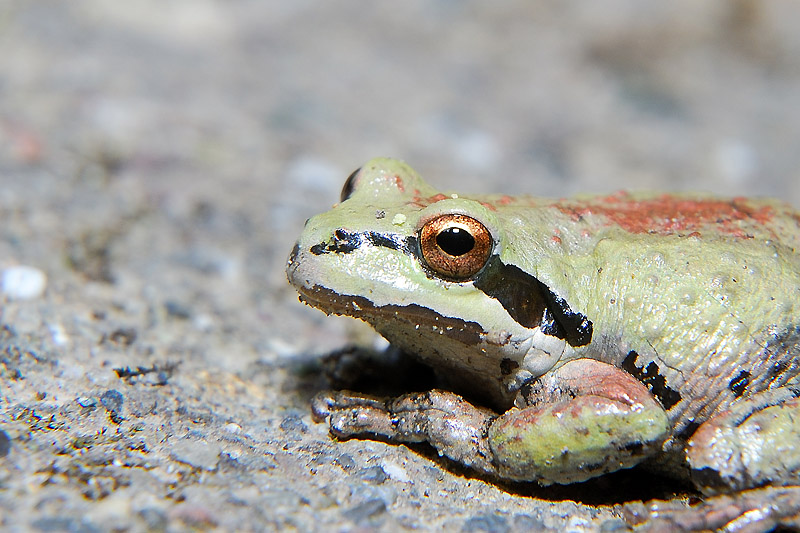

I do wonder if the sudden rush of water in our area creeks this March had an impact on any eggs laid earlier in the season. The creeks were getting quite low in February, due to our lack of rains. As we were wrapping up construction on the goat barn, I remember hearing a deafeningly loud chorus of frogs down near the bridge that crosses over one of those creeks. We then had some heavy rains, and the creeks rapidly swelled, which seemed to silence the croaking for a while. I still occasionally hear a few croaks around dusk, but not as often as earlier in the season.
As with many frog species, the adults subsist primarily on a diet of insects and invertebrates, and the tadpoles consume various algae, protozoa, and bacteria.
This species now brings us to six known species of amphibians that we’ve found living on the farm.[1] The Sierran Tree Frog is apparently the most common frog species in California, but common doesn’t make it any less special. Finding so many amphibians thriving here suggests to me that their environment is relatively healthy, and it’s a constant reminder as to why it’s important to be careful not to pollute our local waterways.
As this frog wasn’t safe where she was, I carefully guided her off the road, and over toward some of the native strawberry plants at the edge of the woodland, where she blended in with her surroundings quite well.
I just hope it’s not another five years before I spot the next one…
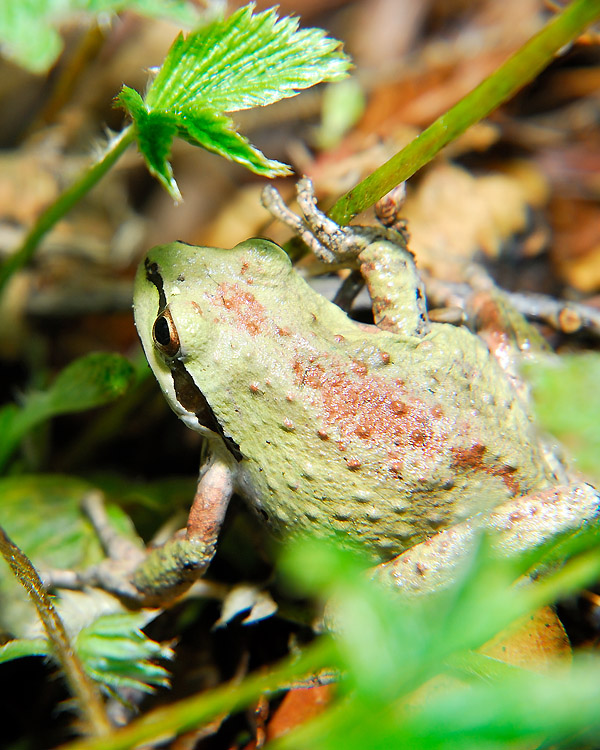
———————————
We leave all wild animal species at Curbstone Valley in their natural environments, and are careful not to damage sensitive habitat and hiding places. Note that it is illegal to collect and possess native amphibian species in California without the required licenses and/or permits.
———————————
[1] Other species of amphibians sighted at Curbstone Valley Farm include: California Slender Salamander (Batrachoseps attenuatus), Coast Range Newt (Taricha torosa torosa), California Giant Salamander (Dicamptodon ensatus), Arboreal Salamander (Aneides lugubris), and the Yellow-eyed Ensatina (Ensatina eschscholtzii xanthoptica).

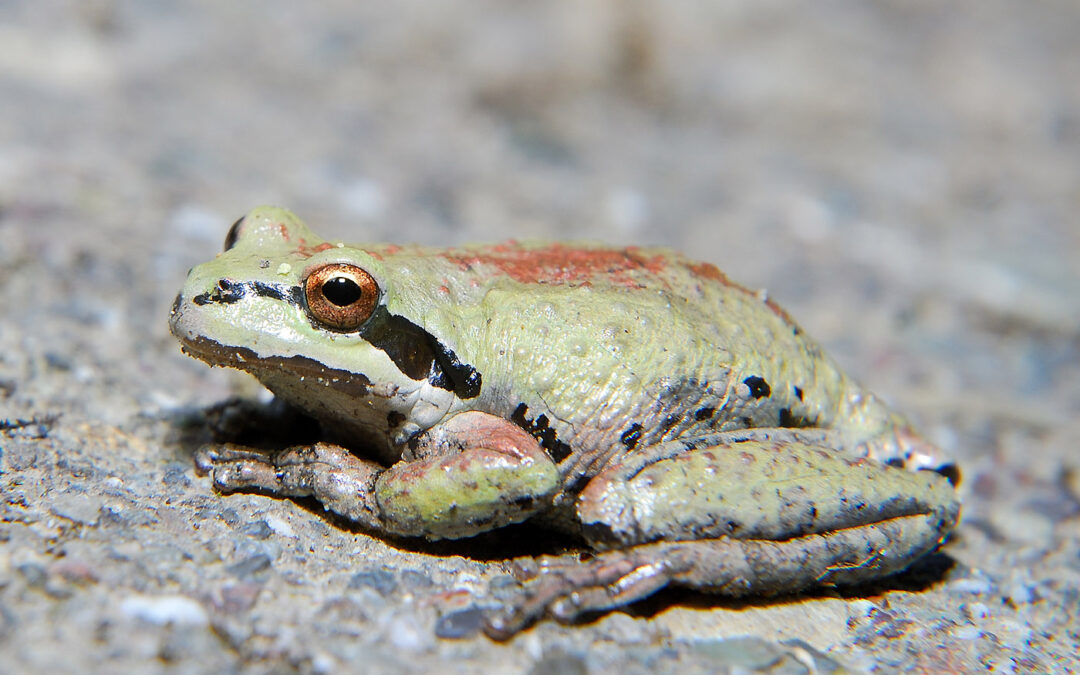
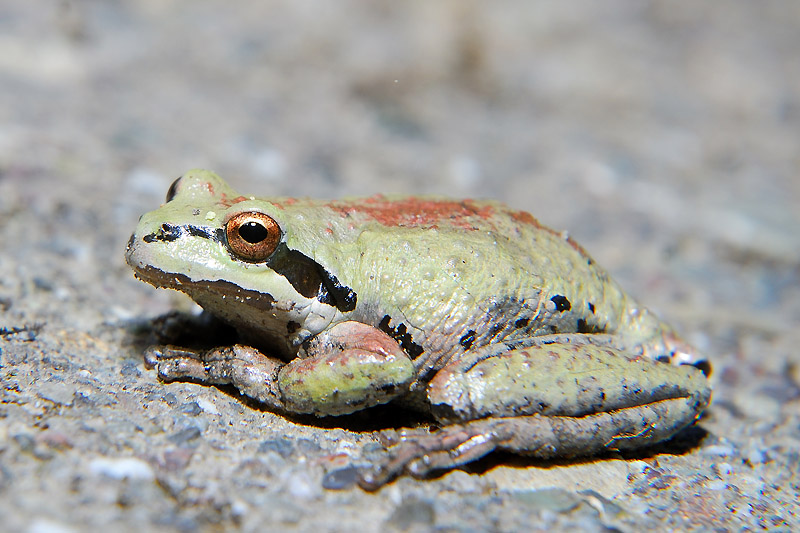
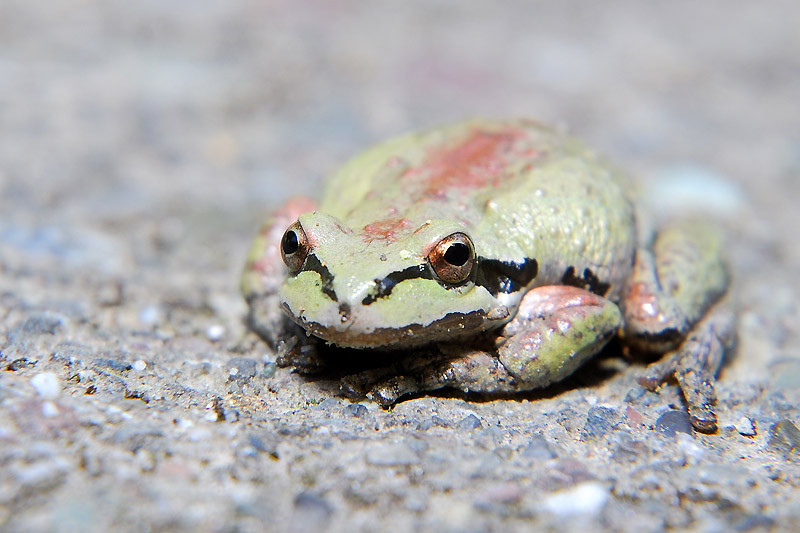
Very cool. Now that I’m living in a really rural area I’m loving all the wildlife. No frogs yet but the bluebirds and quails have been frequent visitors to my yard. No lizards at all so far. I’m wondering if it is just too cold right near the ocean for lizards. Or maybe they will show up when (if) it gets a bit warmer in Summer.
I’ve seen lizards in coastal gardens here. I expect once the weather warms a little more they’ll start to scurry around. I’m a little jealous you have bluebirds!
That is a beautiful frog, and I think she knows it! She was quite a model for you! I wonder if she was a little stunned and trying to figure out which way to go. Thanks to you, now she will find a better tree than your ladder!
I think you might be right, she might have been a little stunned or scared that she was suddenly thrust out in the open in the sun, after hiding under ladder. I’m just glad Mr. CV saw her, as she would have been right in the path of the tractor!
Clare,
First look I said chorus frog, very cute little one. z
We have the Upland Chorus Frig here, the call is easy. Grab a plastic comb, run your finger over the teeth, that is what it sounds like. Not seen one this year, heard lots. Everyday we see Spring Peepers and Northern Cricket Frogs here.
I don’t think I ever really appreciated just how many species there are in the Pseudacris genus. I’m always amazed how loud these chorus frogs sound. How can so much noise come from a creature so small!
Great photos, and a great find. I must hear a million more frogs than I see, especially the treefrogs. Or chorus frogs. Or whatever they’re called this week. Wonderful post.
I just assumed I must have been really inept at finding frogs. Even yesterday we walked down to the creek, where there’s a wide open calm area at the base of a small fall. Not a frog, nor frog egg, nor tadpole to be seen. They’re so loud when all the males are croaking near the bridge, but I just can’t figure out where they’re all hiding! 😉
She certainly has beautiful coloured markings……….and certainly the prettiest frog I’ve seen. I would love to hear a chorus of frogs someday.
The pinkish coloring on her back was quite unexpected. I always expect frogs to be a shade of green or brown. It just seemed like such an unlikely color. Although, if she likes to hide in our strawberries, I suppose pink would be a perfect color!
this surely is not Pseudacris but the Regal Sierran ladder frog (ribbit regallia scala). No point looking so artisttically stunning and not waiting around for a close up. a Happy Easter to you Clare and all at CV
Laura, I almost spat out my coffee across the keyboard when I read your comment this morning. I love ‘Regal Sierran Ladder Frog’, so much more than all the other common names. I may just have to unofficially rename our local population 😉 Happy Easter!
Beautiful shots! The one frog that’s been visiting my pond certainly doesn’t like me anywhere near it — you’re lucky to have been able to get these shots!
I was very surprised to be able to take pictures so close. I’m so glad our neighbors can’t see me when I’m laying flat out in the driveway, stalking frogs with my camera. It was very lucky, but 99% of wildlife photography, at least for me, is luck!
Fantastic post. I love learning about the creatures we share our garden with.
I have fun keeping track to who’s who in the garden, and seeing who’s new. It’s a wonderful reward for all the hours spent in the garden, when the local fauna appreciate what you’re doing too…even if it’s simply installing a ladder behind a workshop 😉
Clare what a remarkable visitor…i love the coloring and markings…she’s gorgeous…our frogs are still hiding below ground and even the peepers have gone back to hibernating with the cold…soon I hope to see them if it ever warms up at night.
I was surprised to be hearing our chorus of frog in February, as I expected it was too early in the season. Although February was actually very pleasant weather-wise, and in a normal year we never could have built a barn in mid-winter! I just hope our heavy rains didn’t put on a damper on these little frogs, as I’d love to see many more of them here in the future.
Oh, I love frogs! That sounds like such a fun encounter. I hope a few of the eggs will make it – I agree, the weather has been rather temperamental.
Now I just wish I could figure out how to have frogs her. A neighbor of a friend has some, but he takes extraordinary measures such as having rotting fruit around to have enough insects. Much better to live closer to the coast and to do without pesticides.
In Davis, we built a pond, and the next spring we had swarms of tadpoles. Maybe you need a small pond at ground level? I’m a firm believer that if you build it, they will come!
That is a very pretty frog! Lovely shots too, you must be chuffed she posed so long.
I was very pleased that she was so patient. The only time I’d seen one of these frogs before was down near the creek last year. It was a small juvenile, less than inch long, hopping across the path…and then he was gone. Of course, I didn’t have my camera then, so I was especially happy I had time to grab my camera this time!
I am glad you ‘saved’ the frog from being squished as roadkill. I am sure his identity crisis went unnoticed since he surely doesn’t care what we homo sapiens call him. I wonder what he calls us? When I saw his picture, he did not look like a tree frog, but when you zoomed in on the feet, I can see why. I saw many tree frogs in Costa Rica, so I guess it was because he was less colorful, but he still has those huge suckering feet.
I wouldn’t have guessed treefrog either. The ones I remember in Costa Rica were quite slender, not nearly as large, or a wide, as this female!
Gotta love wildlife that sits still for not one, but two trips for equipment! You captured some lovely images of a very photogenic (and cooperative) subject.
My latest wildlife sighting here is of the slithering kind. I haven’t even got a good glimpse of the subject, much less had time to get the camera.
I was shocked. How often does it happen that we have a great wildlife encounter in the garden, with our camera in hand, and ready to go? She was so patient, and I was so grateful.
Beautiful photographs – I am jealous. I have been hearing frogs outside my bathroom window for more than a week, but haven’t managed to spot one yet. When I eventually do I am sure my camera will be inside!
We’ve heard them for so long. I remember one year when it sounded like one was in our gutter above the office window. Knowing these frogs are excellent climbers, maybe it really was up in the gutter!
She really is quite beautiful, lots of colour there. Nice to know there’s a thriving population on your population. As you point out, they are a real indicator if anything is amiss in the environment.
The pinkish tone on her back really surprised me. It wasn’t a color I expected in a frog here. A tropical one perhaps, but not here. Amphibians (and fish) are very sensitive pollutants in their environment. The fact we see so many amphibians here, and seemingly healthy ones at that, makes me very happy.
What beautiful eyes on a frog! I often see tree frogs around here, maybe because we live near some forested area. I hope your frog is the first of many spottings!
The eyes were beautiful. I’ve never seen such amazing eyes, and never expected to see them in a frog! I hope we see more soon too!
wow, what a heavenly series of shots! I’m thinkin’ it’s a gravid (preggers) female as she’s pretty roundy-wide (that’s technical talk).
When they changed the species name away from Hyla regilla I was sad, as a co-worker I used to check traps with used to sing “Holla” every time we found H.r. in the traps. =) Alas, no more.
WONderful photographs. VERY glad you took and shared. Who knew she had such beautiful eyes?
I didn’t want to comment on her waistline, in case I was wrong!
Taxonomists…love ’em and hate ’em. I love that we can more accurately allocate species, beyond mere morphological characteristics, but darn it, this DNA sequencing of species (plant and animal) means most of what I once thought to be true, is now wrong. Good grief, they’ve even changed the names of half the dinosaurs, and I was a whiz in Palaeontology in college 😛